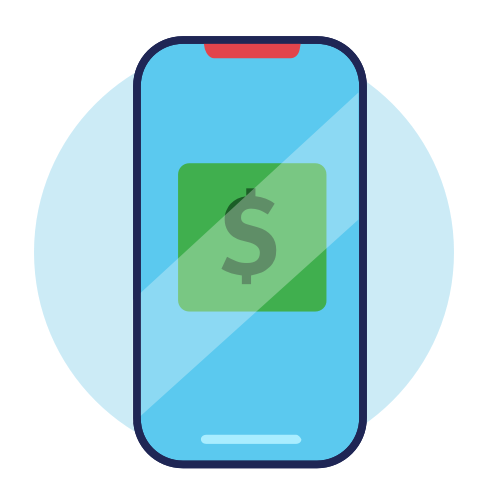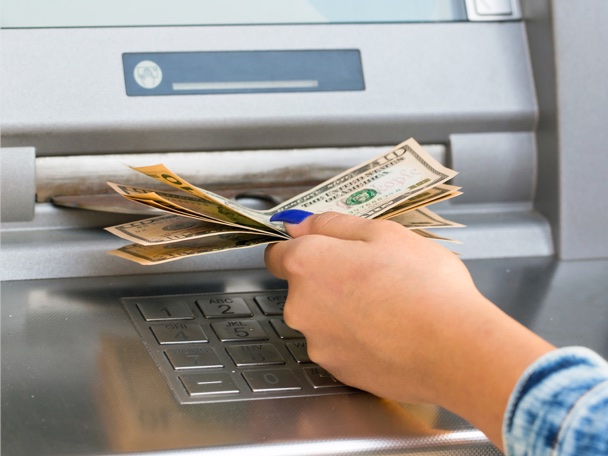
Using Financial Services
Your students will be choosing from a growing number of services offered by banks and other financial institutions. These resources will help your students safely and efficiently achieve financial goals.

How Our Family Banks
Banking has changed significantly, and students have several options. This guide gives tips for parents on discussing their families’ banking choices, helping teens choose a payment method when shopping, and providing opportunities for them to make financial decisions (and mistakes).
Understanding Financial Institutions
Your students will consider how can banks and credit unions help them achieve their financial goals? Use these resources with your students to explore the various services offered by financial institutions.

Understanding Financial Institutions
In this module exploring financial institutions and the products and services that they offer, students learn that interest is both paid to savers and charged to borrowers as they examine common banking transactions, explore several banking alternatives, and discover the benefits and risks associated with each.
Supplemental Resource Links
Introductions to Depository Institutions
You can set up an activity for your students: After watching a video and discussing the benefits of depository institutions such as banks and credit unions, students help a character choose a financial institution. (When you get to the site, please create a free account to access the resources. Once logged in, the link above will take you directly to the resource.)
How to Get the Best Banking Experience
Your students can learn why people bank, what account types are available, how to automate payments and savings, and the importance of avoiding fees.
Millions of ‘Unbanked’ Americans Lack Adequate Access to Financial Services
Share this 8-minute video and explore why many Americans are “unbanked” and efforts are underway to build trust in financial institutions.
Banking Basics
Build students’ understanding of financial institutions with this article that includes vocabulary terms and a set of questions for students to answer. If you register with the Econ Lowdown Teacher Portal, you can access additional resources.
National Survey of Unbanked and Underbanked Households
Explore the FDIC’s interactive map and find out how your state or nearest metropolitan area’s rate of unbanked households compares to those of other areas in the country and/or the national average.
Deciding Where and How to Bank
What factors should students consider when selecting a financial institution? Help them learn how to compare features and costs of services offered by financial institutions.

Deciding Where and How to Bank
This module will give your students an overview of factors to consider when choosing where to bank. They will learn how to compare features and costs of services offered by financial institutions.
Supplemental Resource Links
Bank Your Bucks: Choosing a Banking Partner
In this lesson, students conduct a comparative analysis of different financial institutions and explain the differences between checking and savings accounts.
About Credit Unions
Explore information about credit unions, including what it takes to be a member and which ones have federal insurance.
My Banking Checklist
Use this tool to compare three different financial institutions with questions ranging from your personal needs to the products each offers.
How to Choose a Bank
This article explores factors to consider when selecting a financial institution.
Opening New Accounts
What financial products will your students need? How does one open an account at a financial institution? Use these resources to help students determine what financial products they might need and what information they should have to open an account.

Opening New Accounts
Students learn what to expect when opening a new account with a financial institution, including questions to ask when selecting an account, specific information they will be required to supply, and common fees they should understand when opening their new account. Finally, they review steps to take once their account is open.

What to Expect When Opening a Checking Account
What information and documents will you need to open a new account? Students learn about opening checking accounts. A collaborative activity prepares students for opening an account.
Supplemental Resource Links
Checking
This complete unit plan includes lessons, activities, and projects on checking basics, online and mobile banking, and selecting and opening a checking account. (Portions available in Spanish.)
NGPF Bank Simulator
Try your hand at managing a bank account with this free simulation.
Checklist for Opening a Bank or Credit Union Account
Help students be prepared when they go to open a checking account with this checklist of information to bring with them and questions they can ask.
Manage My Checking Account
Share these helpful tips for managing a checking account, including ones for both new and more experienced account holders.
Bank Overdraft Fees
This video provides an overview of bank overdraft fees and offers alternatives to avoid fees charged by some financial institutions for this service.
Checkbook Balancer
Try out this interactive tool to help balance a checkbook.
Using Mobile Banking
Your students are likely to prefer to bank from their phones or tablets. Help them learn how to bank safely from their devices. Share these tools to explore common online and mobile banking features, and learn how to prioritize personal mobile banking needs.

Using Mobile Banking
This module will guide your students in how to bank safely from their mobile devices. They will explore common online and mobile banking features, and learn about other mobile financial tools.

Banking on the Go
This module will guide your students in how to bank safely from their mobile devices. They will explore common online and mobile banking features, and learn about other mobile financial tools.
Supplemental Resource Links
How Mobile Banking Works
This article explains how mobile banking started and what happens behind the scenes of mobile banking transactions.
Online and Mobile Banking Tips for Beginners
If you or your students can use help getting started with mobile banking, follow these tips.
Banking With Apps
Explore the differences between mobile banking apps from banks and non-bank companies, including what that means in terms of FDIC insurance.
Dial M For Money: Can Mobile Banking Lift People Out Of Poverty?
National Public Radio explains how people in Kenya are using mobile banking to improve their economic well-being.
Making Everyday Purchases
Show your students the difference between using cash, debit, checks, and credit. Help them understand the costs and benefits of using various methods of payments for everyday purchases.

Making Everyday Purchases
In this module, students are encouraged to consider the payment method they use before making a purchase. The module begins with students identifying payment methods they have used or seen used in the past. Students learn about different types of payment methods and factors to consider when selecting a method of payment.

Deciding How to Pay
How do you choose the best payment method for everyday purchases? Students consider how cash, electronic payments, or debit and credit cards can be applied to real-world scenarios.
Supplemental Resource Links
Credit Cards vs. Debit Cards: What’s the Difference?
Review the differences between debit and credit cards with students.
Credit Cards
Use this simple infographic and the accompanying video to explore the differences between credit and debit cards.
Is It Safe to Use Peer-to-Peer Payments?
Invite students to learn why sending money to friends and family is generally safe, but there are scams they should try to avoid.
Is Cash Going Extinct?
Consider if there will be a time when we won’t need cash and whether it is legal for businesses to refuse cash for payment.
What is a Digital Wallet?
Find out more about the digital wallets found on smartphones, watches, and more, including how they work and the pros and cons of using them.
